MONASTERIES OF UKRAINE AND ROMANIA
Romania is a country of monks (over 20,000!). In Ukraine is one of four shares of the Virgin Mary, in the Universe, the famous Kiev Pechersk Lavra. On this trip, we visited the most important holy places, of these two countries. In every place, we were warmly welcomed, by brotherly Orthodox people of Ukraine and Romania.
This was the route: Belgrade-Budapest-Pochaev Lavra-Kiev Pechersk Lavra-monastery Banceni-Iasi-monastery Neamt-monastery Secu-monastery Sihastria. We visited all of this, in 7 days. This tour is accessible to all, because gas in Ukraine is twice cheaper than in Serbia, while the price of gasoline is about 40% lower than in Serbia.
We overnight at Budapest. Distance between Belgrade and Budapest is 373 km, by the highway. In the early dawn, on Monday, we started our trip to Ukraine and Pochaev Lavra. Distance between Budapest and Pochaev is around 700 km, so it took us about 11 hours by car. The main roads, in Ukraine, are not in the best condition. Some sections of the road are really good for driving, while some have a lot of holes and furrows, so you can not drive like on the highway. Do not drive by the side roads, they are in very bad condition! My advise is to buy a map of Ukraine, at a gas station.
So, from Budapest, follow the signs to Nyiregyhaza. Then follow the signs toward Zahony (UA) and Beregsurány. From the city Beregsurány, follow the table with sign UA (Ukraine), to the border. From the border, just follow the main road, toward Kiev. While traveling through the Ukrainian Carpathians, you will enjoy in the unusual beauty of Russian churches.
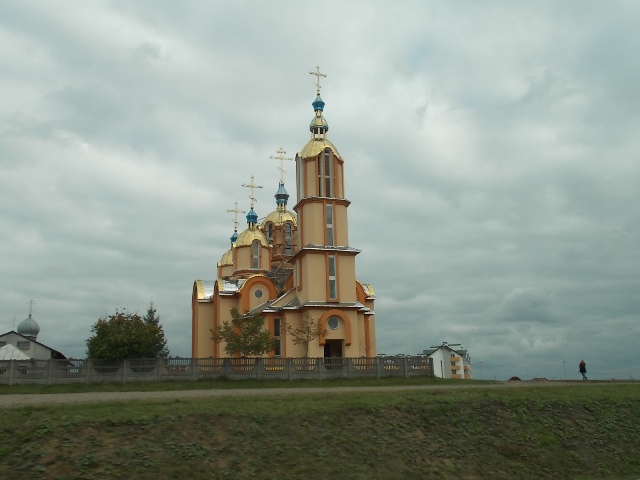
Ukraine
The main road is OK, but the mileage is long. When you see the first signpost for Pochaev, turn toward it and follow the signs. Soon, the great Pochaev Lavra of the Holy Dormition of the Theotokos, will appear!
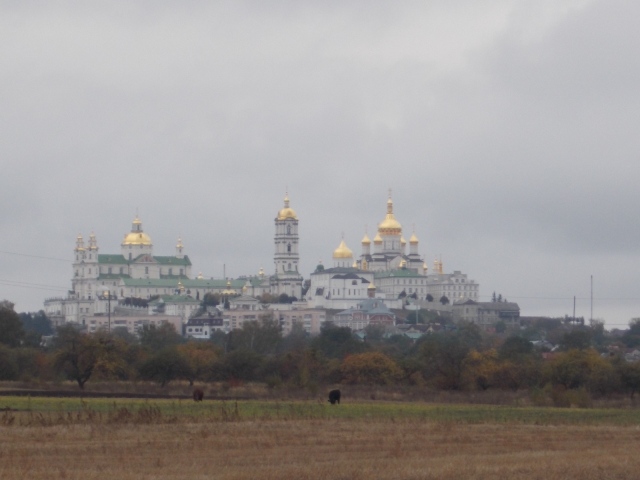
Pochaev Lavra
Like all the Russian monasteries, Pochaev Lavra is also luxurious. Inside, everything is in perfect order! Pochaev Lavra was founded in 1240. That year, the Mongols invaded Russia. Monks from Kiev Pechersk Lavra, pressed by the Mongol yoke, came to the area of Pochaev. The Mother of God appeared, in front of them, in the form of the flaming bush and stepped on the rock, with her right foot, from which the water flowed. A footprint on the stone is still kept, in the main church of the monastery. The monks first built a wooden church, which will be the precursor of the latter monastery. This area they called Pochaev, according to river Pochaev, which is one of the influents of the river Dnieper.
In 1597, the monastery received, as a gift, the miraculous icon of the Mother of God. The icon was a gift of Anna Goyska, a local landowner. Ana Goyska received this icon from the Greek bishop Neophyte, in 1559. The icon has healed her brother Philip, who was blind from his birth. She decided to donate it to the monastery. The icon now stands high above the altar, in the main church.
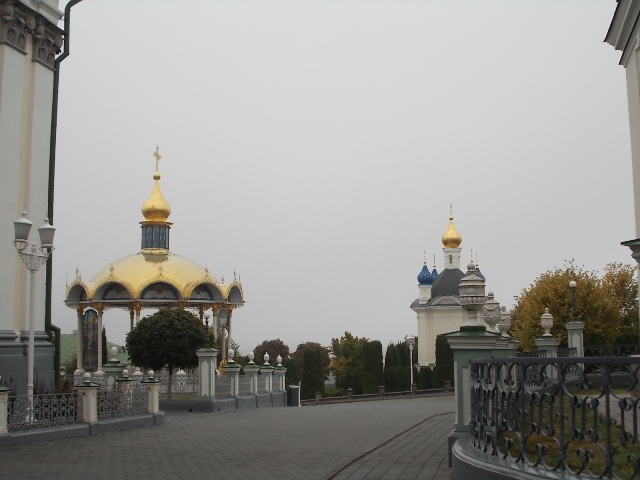
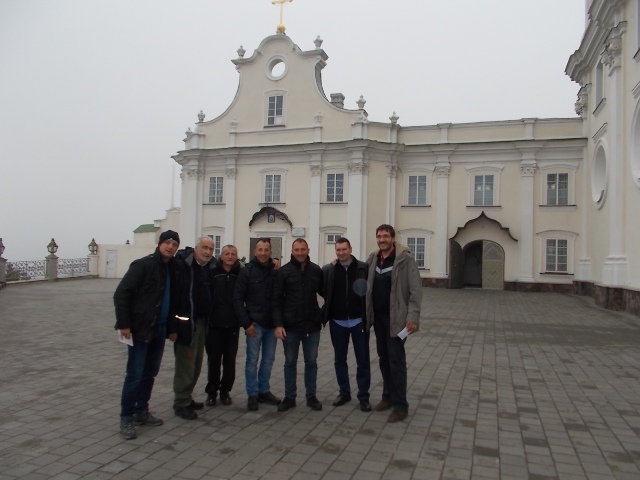
Serbs at Pochaev Lavra
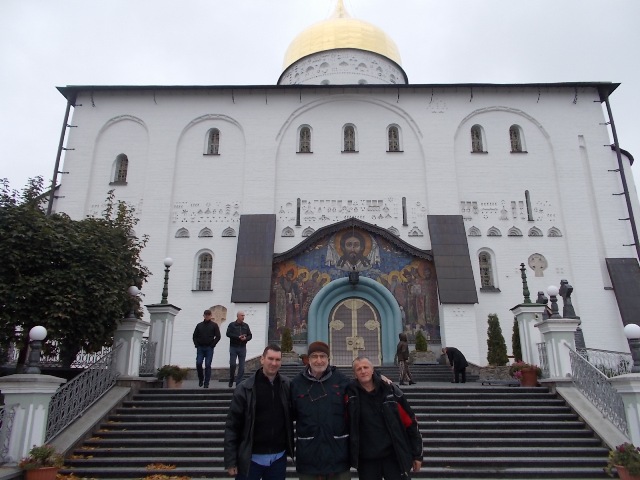
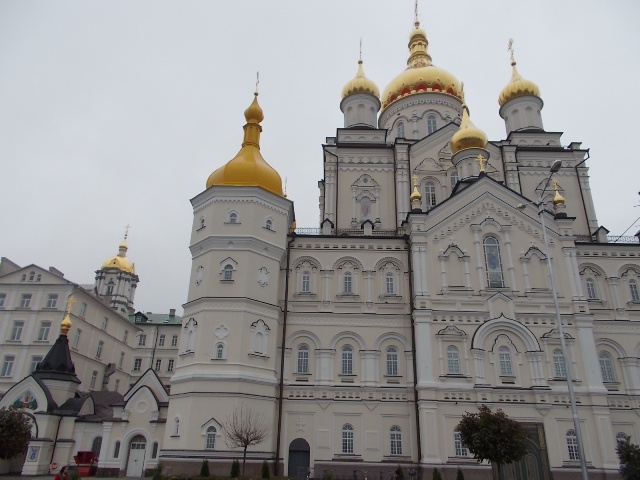
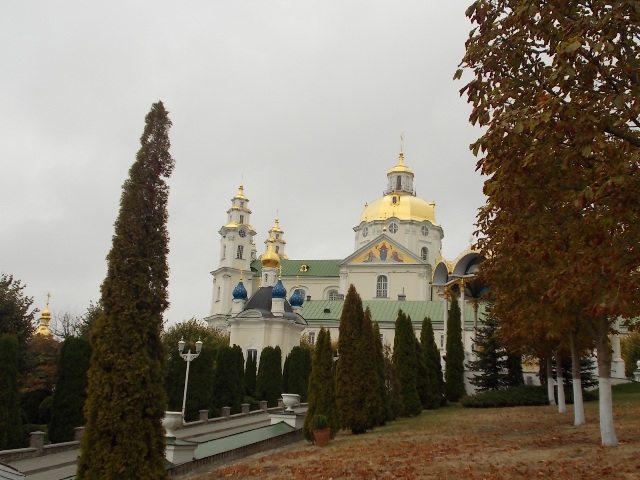
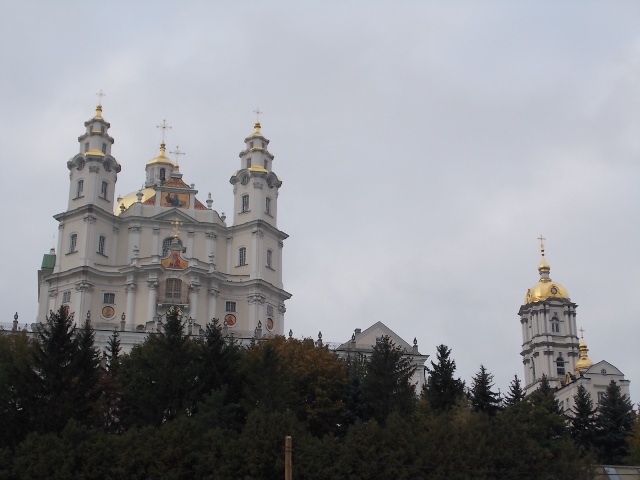
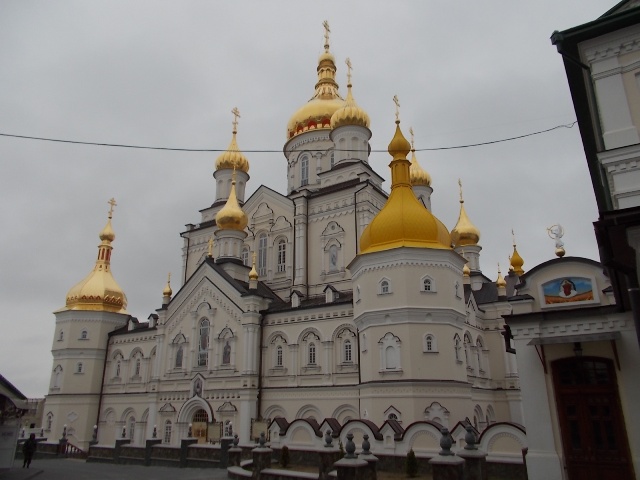
In Pochaev Lavra, the relics of two saints, St. Job and St. Amphilochius of Pochaev, lies. These relics are kept in the church of St. Job, behind the main church. St. Amphilochius of Pochaev reposed in 1971. He was the great wonder-worker and healer. St. Job was the abbot of Pochaev Lavra. He Died in 1651, when he was hundred years old! In the church of St. Job is the cave, where this saint lived. Entry into the cave is a test of our faith, struggle with ourselves. The opening of the cave is very narrow, so you can enter only if you lie on the side and then slip inside, like a fish. Sometimes, a man of 130 kg can pass through the opening without a problem, but, sometimes, a very thin and skinny person can not pass! It all depends on their own sins. The opening of the cave is “alive. It narrows and spreads; you can hear and feel it! When you slide into the cave, you will find yourself in a small hallway and, after two steps, you will stand on the stone, on which St. Job prayed day and night. In this cave, the Venerable Job had visions of the Virgin Mary. Sometimes happens that the person manage to get into the cave, but can not get out. Then the priest comes, the sinner confesses to him, and then he gets out, without problem! St. Job does not punish, but use this way to help us, to clean our sins.
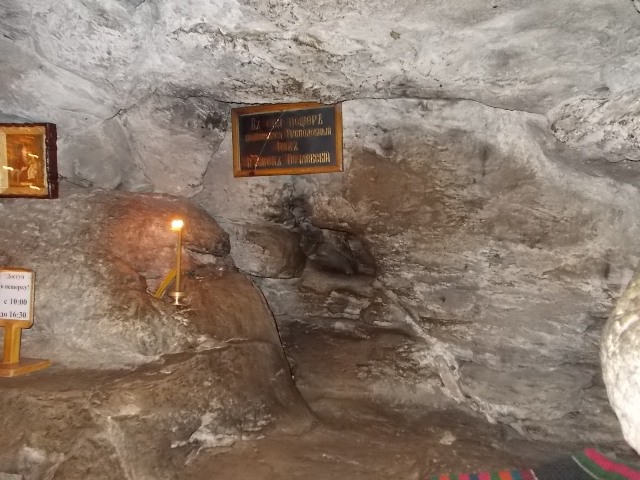
Cave of St. Job
In the village of Pochaev, everything is very cheap. Night in the monastery costs 3.5 euros. The monastery dining room is quite good, with various meals. For 1.5 euros, you will be more than full-fed. Icons, crosses, etc, are very cheap, but pretty good quality. The Ukrainian currency is hryvnia. One euro is 28.5 hryvnias. On the website www.pochaev.org.ua, you can book your accommodation.
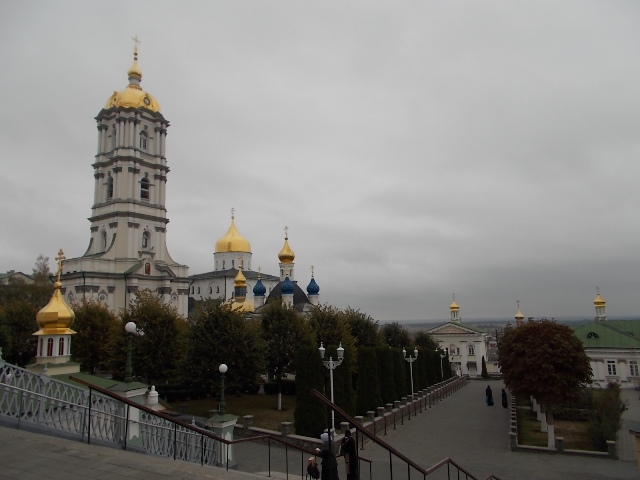
Now, I want to share, with the readers, my spiritual experience of this sacred monastery. As soon as I stepped into the monastery, I felt great power and grace. When I entered the main church, the grace overflowed me. I felt great love and peace. In the church is a source of the healing water, which flows out from the footprint of the Virgin. Ukrainians are strong in faith and they highly respect this holy place.
During the evening service, I heard a woman`s scream. First, I did not realize what it was, but soon I understood everything. A lot of demon-possessed people are coming to Lavra, with the hope of healing. There are also plenty of mentally ill and disabled persons, but the majority are the ones who are possessed. The woman, who was screaming, was aware of her possession, but, at the same time, unconscious of the influence of the demons. She was screaming and crying, sometimes talking with a deep, male voice, accompanied by inhuman screams.
The next day, near the monastery dormitory, I found myself in a chapel. I was alone, with a 5-6 possessed people. Women were screaming and crying, and one man made unnatural gestures, with his whole body, howled and barked on the icon. My companions saw a 15 year old boy in handcuffs; he was led to the main church. In Pochaev Lavra, priests expels demons from the people. During the service, but also before and after it, they read prayers of exorcism. When possessed people are close to the holy relics, the demons in them are screaming, they can not bear the great power of the sacred relics. One woman was led by the police and brought before the icon of the Virgin of Pochaev – that cry I have never heard in my entire life! The woman spoked with deep, demonic voice, barely kissed the icon and screamed. Can you imagine how sinners are tortured in the afterlife, when demons tormenting them in this one? If you experience what I have experienced, you will deeply think about your sins, which you are making in your everyday`s life.
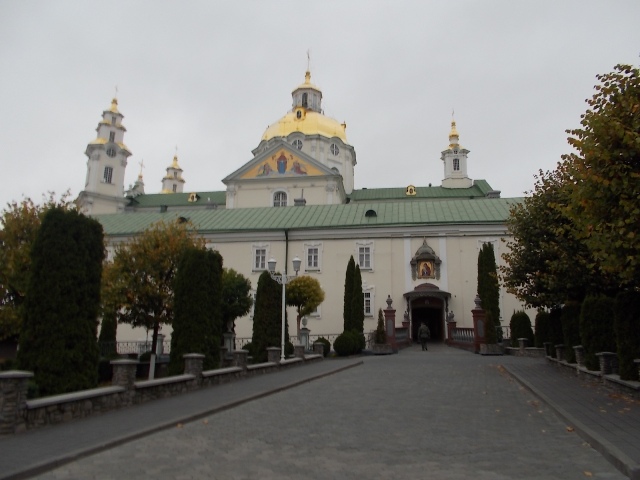
1 km far from Pochaev Lavra, is the monastic cemetery. At the cemetery is an empty tomb of St. Amphilochius. It is easy to find it. In the extension of the road that leads to the cemetery (2 km far from the cemetery), is Sveto-Duhovski skete. The road to the cemetery (and from the cemetery to the skete) is paved and can be reached by car. According to tradition, the skete was founded in 1220. There is an icon of St. Seraphim of Sarov and the fragments of his relics. Beautiful place!
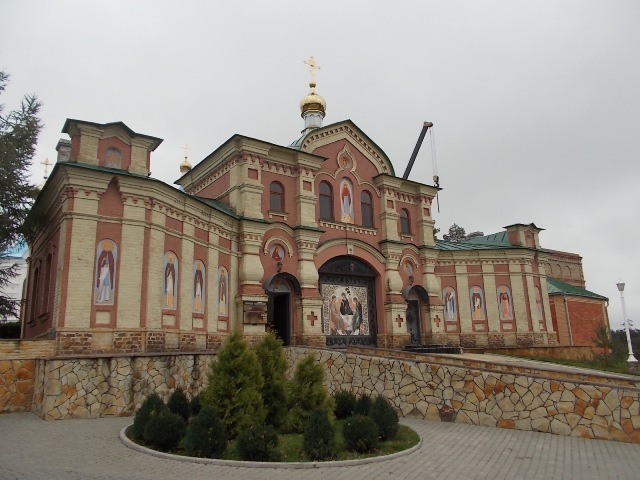
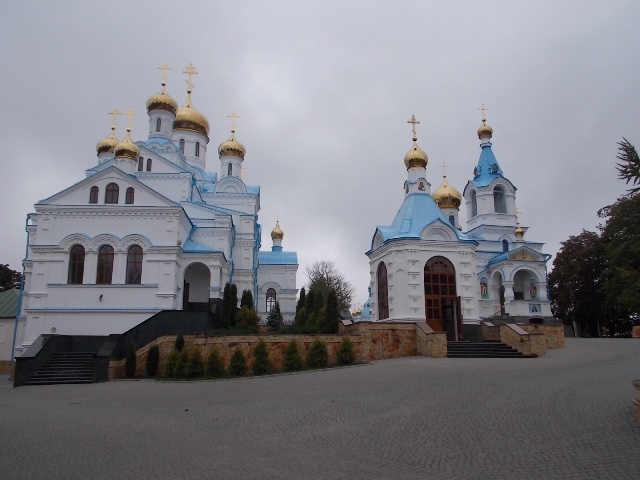
Holy spirit skete
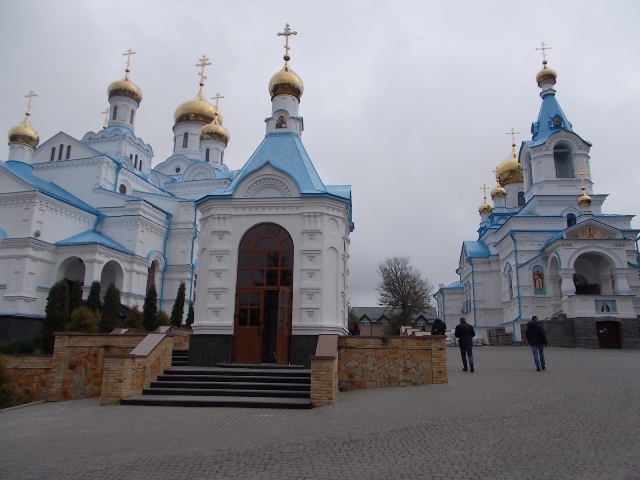
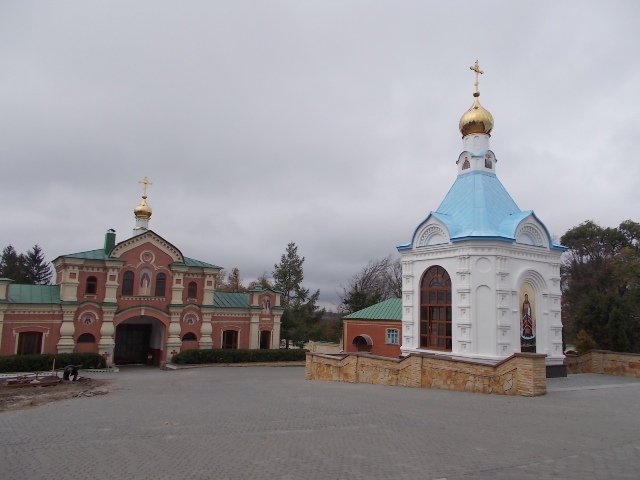
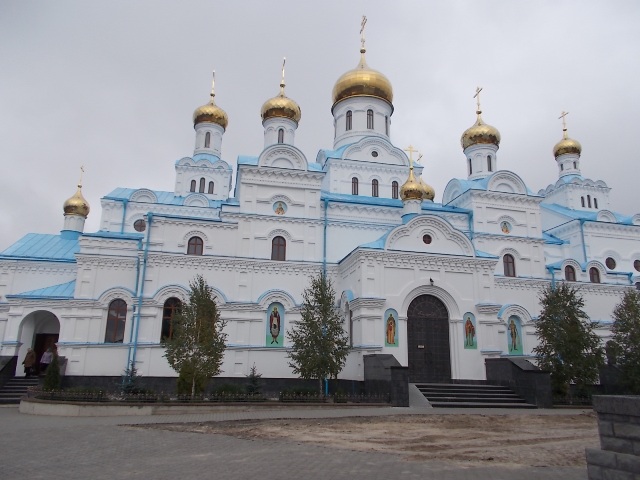
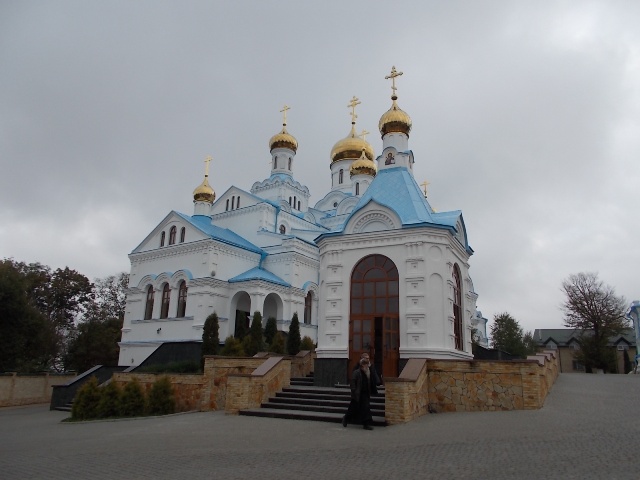
After two days in Pochaev Lavra, we went to the next sanctuary, the famous Kiev-Pechersk Lavra. From Pochaev, follow the signs for Kremenets, Rivne, Zhytomyr and Kiev. Distance between Pochaev and Kiev is 436 km, or about 5 hours of drive. The main road is quite good. Turn on the GPS, but do not turn off your brain!
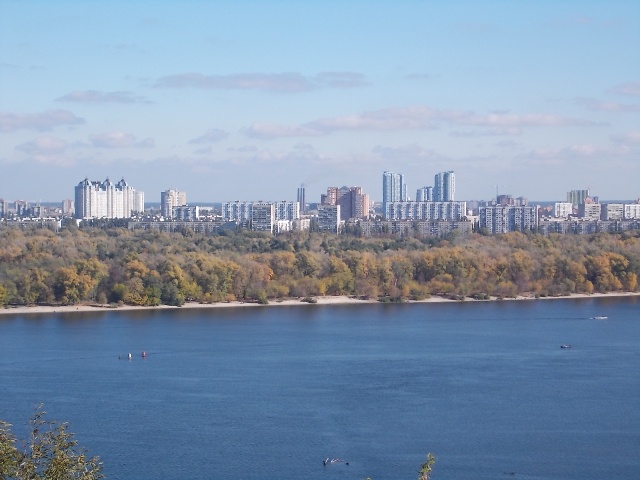
Kiev
When you arrive in Kiev, drive straight, as long as you can. Then turn right, in the direction of the sign “Baseina”. Drive straight, and turn left, in the direction of the sign “Mechnikov”. Continue straight, then turn half-left, so that the church is on your left side. Then drive straight, to the end, and turn left. Again drive straight, to the end, and then turn right and uphill. Next turn is to the right; the sign “Moskovskaya”. Continue to the right, then turn left, in the direction of the sign “Citadelna”. Drive right, to the green dome (where it says “Kynon”) and then turn right. Continue 300 m straight and turn left, at the bus station. You’ll see a ramp; there is an entrance to Lavra.
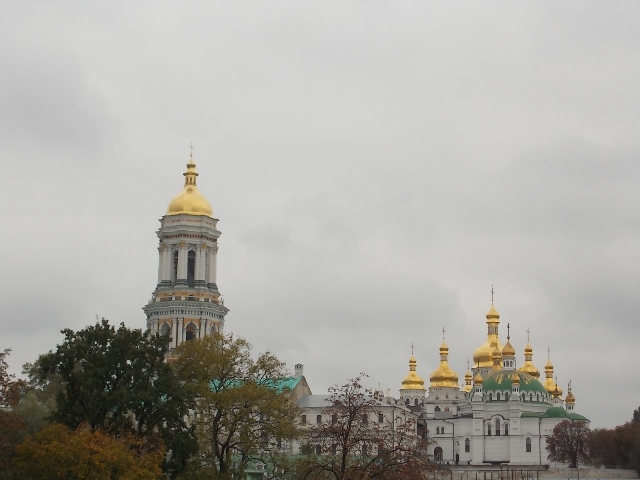
Kiev-Pechersk Lavra
Kiev Pechersk Lavra is really huge! It’s a small town, divided into two parts, the lower and the upper Lavra. There are several buildings, for the accommodation of the pilgrims, so called, corpus. We were placed in the corpus 54. It costs 5 euros, per person. The rooms are neat and clean, with shared bathroom. There are several dining rooms, in the monastery. All the necessary information can be found on the site www.lavra.ua. Six day excursion to Moscow, costs only 90 euros, if you are going at Lavra`s organization.
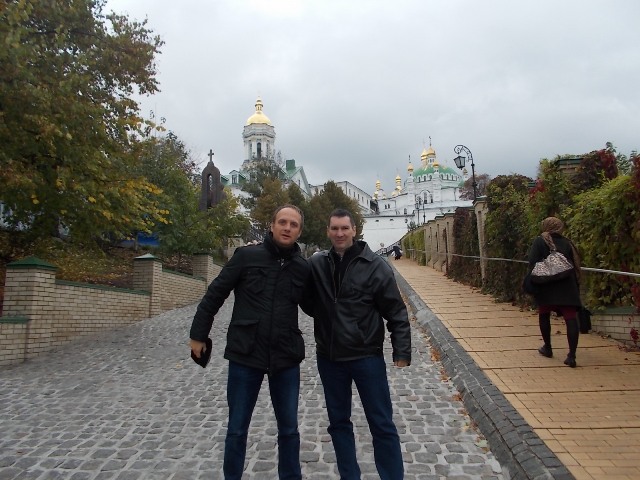
Kiev Pechersk Lavra was founded in 1051. Тhe founder was St. Anthony, a monk from Mount Athos. St. Anthony lived in a cave, above the monastery Esphigmenou, at Athos. The former abbot of Esphigmenou had a vision, in which he was told to sent Anthony back to Russia. And so it was; Anthony came to Kiev and settled in a cave. “Pechersk” in Russian means “cave”. The monks started to inhabit, around Anthony. Following the example of the Holy Mountain monasteries, St. Anthony founded the Kiev Pechersk Lavra. From Mount Athos, St. Antony brought hesychasm and the Jesus prayer. Anthony’s successor, St. Theodosius, continues the work of his predecessor.
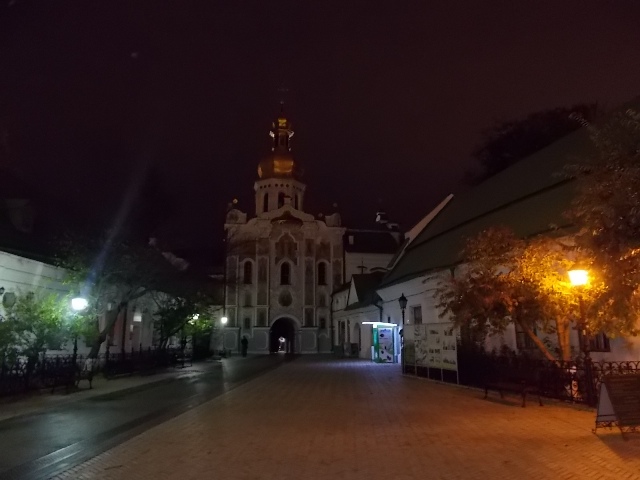
Kiev Pechersk Lavra is a unique place on Earth. And certainly one of the most sacred. In its caves, lies at least a thousand relics of the saints. Caves are divided into “Near”, or Anthony’s caves, and “Far”, i.e, Theodosius caves. Both caves are in the “lower” Lavra. Caves are, in fact, a combination of narrow, bandy corridors. The corridors are 1.5 meter wide. In the “Near” caves, the relics of 73 saints are exposed and 49 in the “Far” caves. Caves lies at 15-20 meters beneath the ground. Even below these 20 meters, there is a hall, but it is forbidden for the pilgrims. On the left and right side of the cave corridors, are niches, with the relics of the saints. In a glass, transparent coffin, lays saints, in their robes. Above each saint is a signpost, with his name. In both caves, three churches exists. Liturgy in these catacombs is an incredible experience!
Beside the saints who are “exposed”, in the caves lies at least thousand relics of saints who were walled up, in their cells. These saints asked his brothers to walled them up and to leave them only one opening, through which they will supplied them with food and water, once a week. These hesychasts lived ascetic and prayed in silence. If the brother, who brought them food, after 7 days found food and water untouched, it would be a sign that the hesychast has died. The cave then became his grave. There are many such graves, in Kiev caves. When St. Anthony saw that his end was near, he said goodbye to the brethren, and went to his cell, in the “Near” caves. The walls of his cell fall onto him and buried him. His disciples have tried to dig him, but, from the side which they dug, fire burst forth. They began to dig from the other side, but the water appeared. Those were the signs, that the saint does not want to reveal his relics. Then, one monk had a vision of the saint, in which St. Anthony told him not to seek for the relics. His cell still exists, in “Near” caves, and the relics of St. Anhony are somewhere around it.
Cell of St. Theodosius is in the “Far” caves. His relics were transferred to the main church of the Holy Dormition, but, after the World War II, they disappeared without a trace. Maybe they lies somewhere in the main church, or are still hidden in caves, nobody knows.
During the World War II, the Germans wanted to destroy all the relics of the saints. They planned to ground them, in the mill. When they tried to move the relics, they could not raise them. The relics were so heavy, that there was no chance to move them! Indignant, one German soldier pulled out a gun and hit the hand of St. Spyridon with it. Blood came from the saint’s hand and the soldier freaked out!
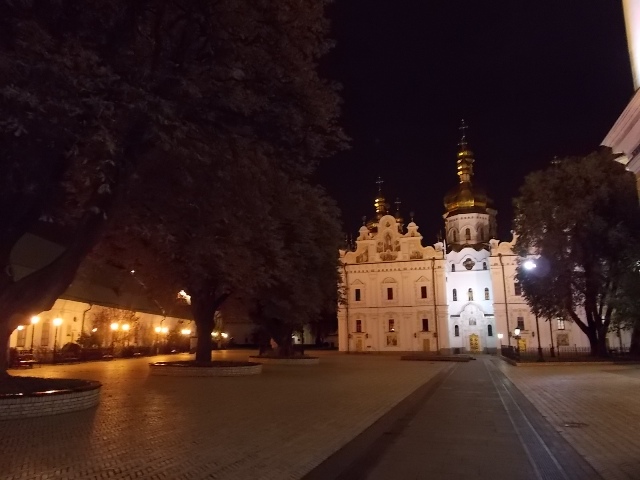
In the “Upper” Lavra, wide, paved street, opens a view at the beautiful church of the Holy Dormition.
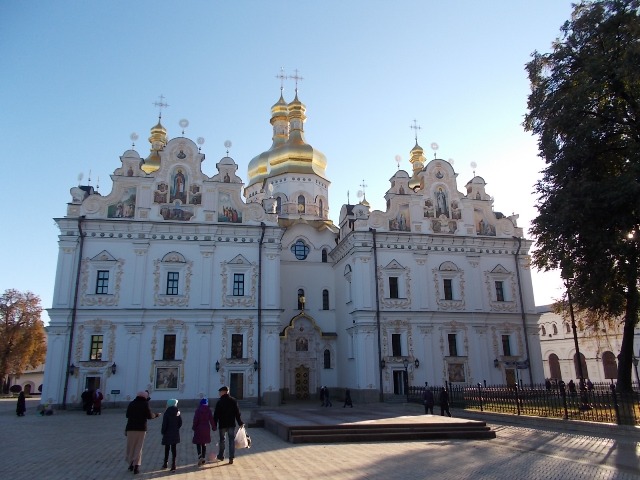
Church of the Holy Dormition
A beautiful baroque iconostasis, covered in gold, exists in the main church. Finger of St. Stephen the Archdeacon is the most sacred relic of the church of the Holy Dormition. The miraculous icon of Virgin Mary, which once stood in this temple, was lost during the Second World War.
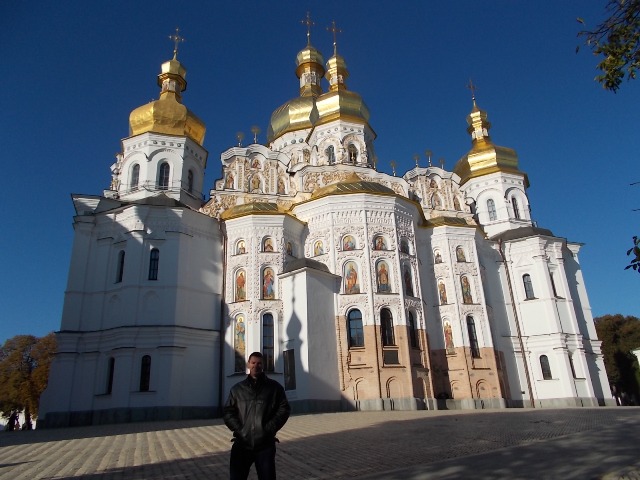
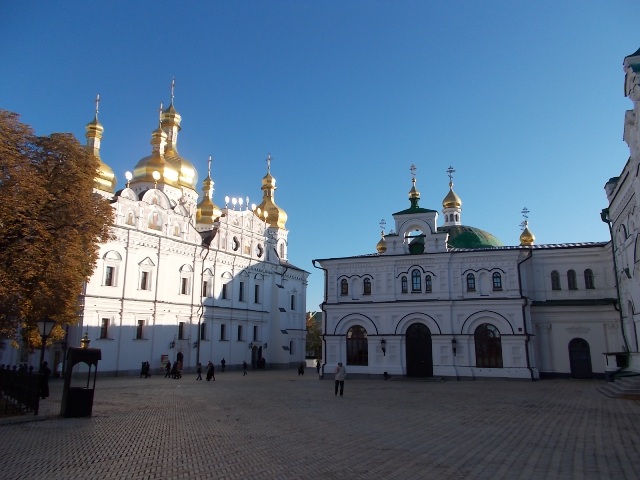
In front of the main temple is the tallest building in Kiev, the monastery Bell Tower. Its height is 96.5 meters. In 1707, its construction began. In 1744, the clock tower was placed.
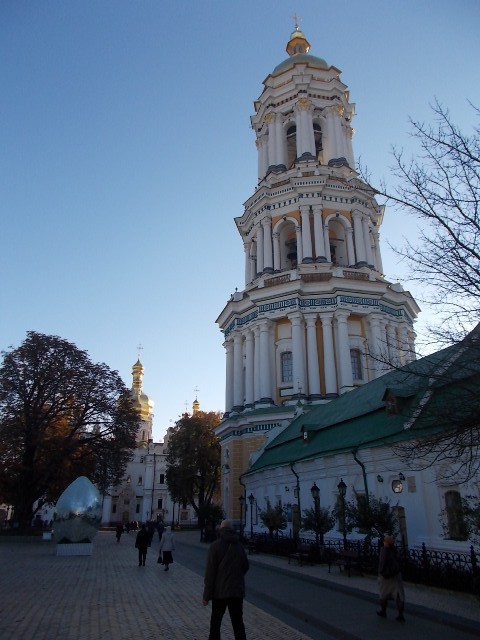
Bell Tower
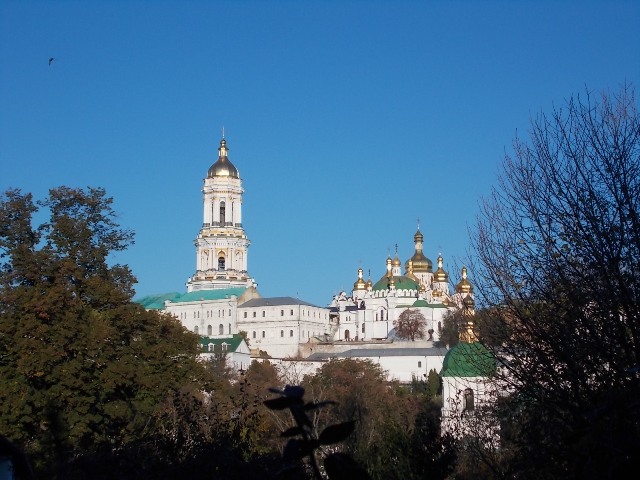
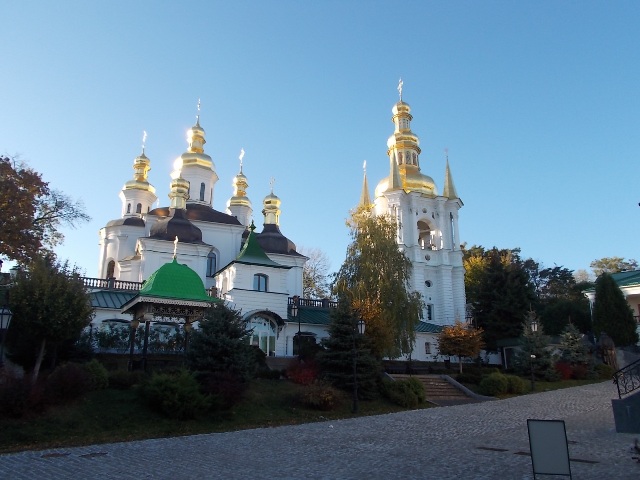
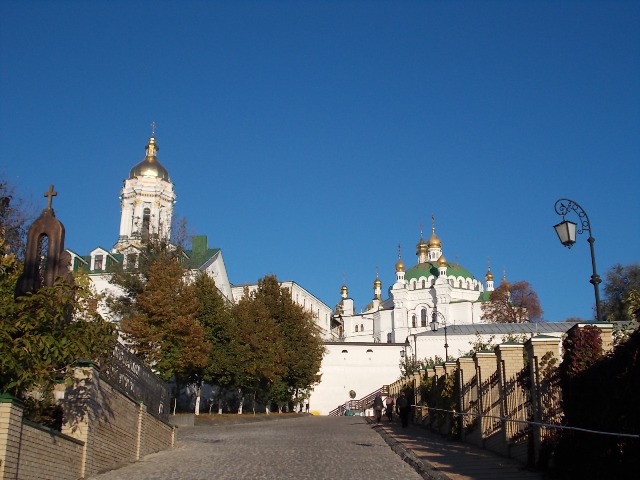
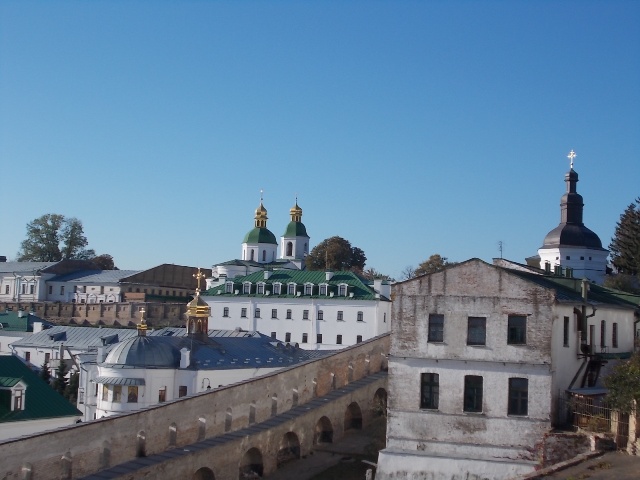
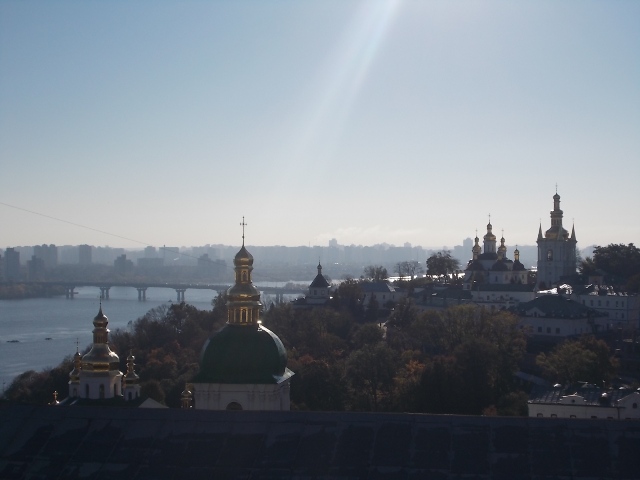
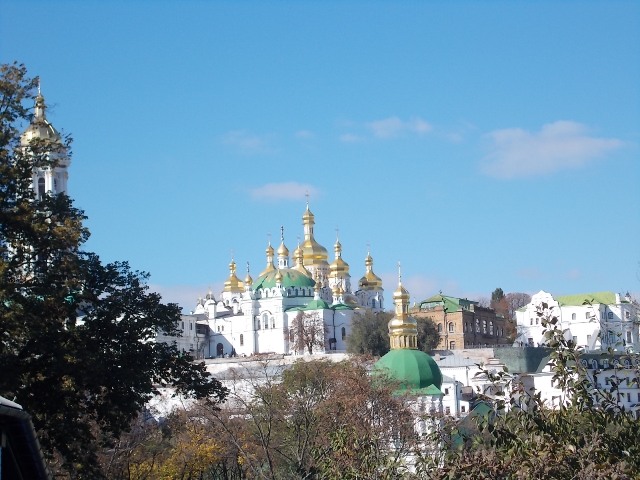
In the evening, we visited two monasteries near Lavra. The first monastery that we visited, is Svyato-Vvedensky monastery. This monastery is located in the city, surrounded by skyscrapers. Svyato-Vvedensky monastery is about 1.5 km far from Lavra. This monastery was founded in the second half of the 19th century. It is famous for the miraculous icon of the Mother of God, “Призри на смирение”. This icon was painted in 1420. During communism, this monastery was closed. After the fall of communism, the monastery revived. The monks wanted to place the icon in the new frame. Icon was removed from an old frame, but the contour of the Virgin Mary stayed on the glass of the old frame! The old frame still stood in the altar; you can clearly see the outline of the miraculous icon. In the crypt of the monastery is the church, dedicated to St. Demetrius of Thessaloniki. In this church, the relics of St. Demetra lies. If you write a wish, on a paper, put it in the saints coffin and, if the wish is good for your salvation, St. Demetra will fulfill it.
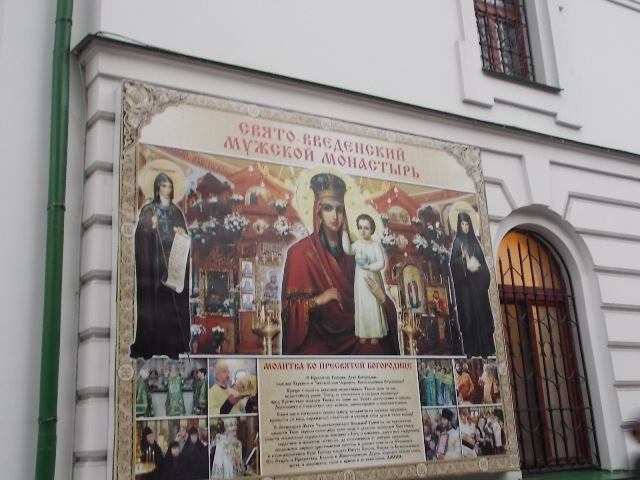
Svyato-Vvedensky monastery
The second monastery we visited is Zverinecki monastery. It is dedicated to St. Archangel Michael. Zverinecki monastery is 3 to 5 km far from Lavra. According to tradition, this is the first monastery that was founded on the territory of Russia, after prince Vladimir, in 988, received Christianity (i.e, Orthodoxy), in the name of whole Russia. Zverinecki monastery was founded by Greek monks from Mount Athos. So, Zverinecki monastery was Greek monastery on the territory of Russia. This monastery also has its caves, with the relics of saints. These relics are not exposed, like those in the Kiev-Pechersk Lavra. The monastery is tucked between tall buildings. I would never guess that the oldest Russian monastery lies here! It was named after the beasts (at Russian-zveri), that once inhabited this area.
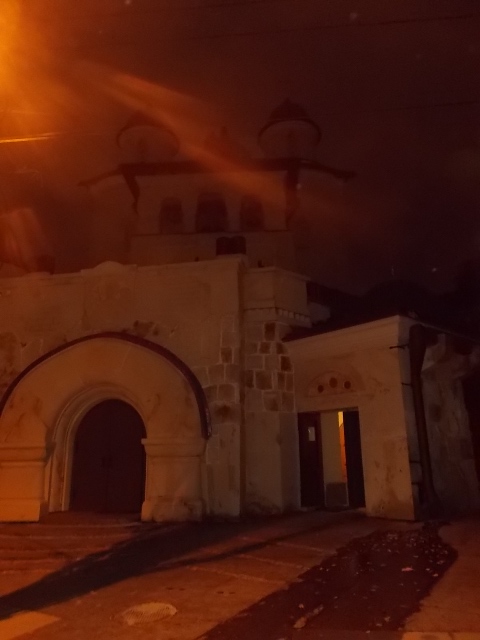
Zverinecki monastery
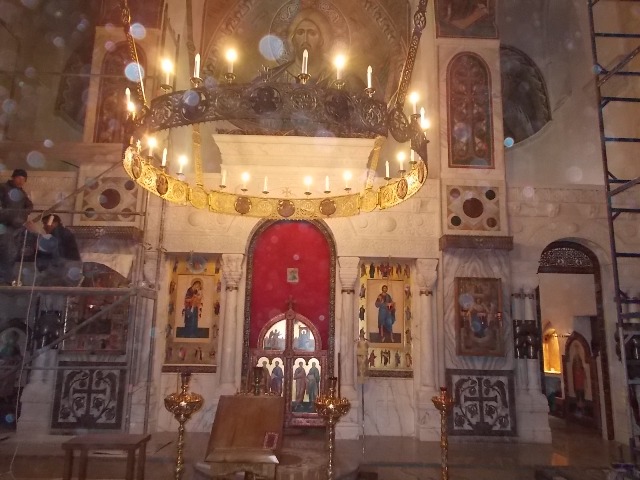
Church in Zverinecki monastery
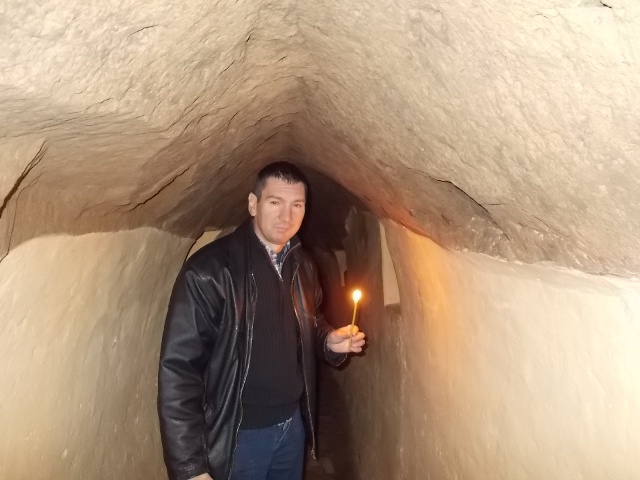
Caves of Zverinecki monastery
Next day we went to Chernigov, to the monastery of Holy Trinity. Monastery is also known as Chernigov monastery. Distance between Kiev and Chernigov is 150 km, or about 2.5 hours of drive. When you exit the Lavra, go left. At the first intersection, turn left again and go straight, over the bridge. At the end of the bridge is a guideline for Chernihiv (Chernysiv or Chernigov) – turn right. Chernigov monastery was founded in the 11th century, probably in 1060. The monastery was founded by St. Anthony, the founder of the Kiev Pechersk Lavra. At the site of today’s monastery, St. Anthony had a vision of the Virgin Mary, on a tree. Soon, he painted the miraculous icon of the Virgin Mary on a tree. This monastery also have caves, where St. Anthony lived. One of the most notable monks of the monastery, was St. Laurence of Chernigov (died 1950). He is well known for its prophecy of the end of time.
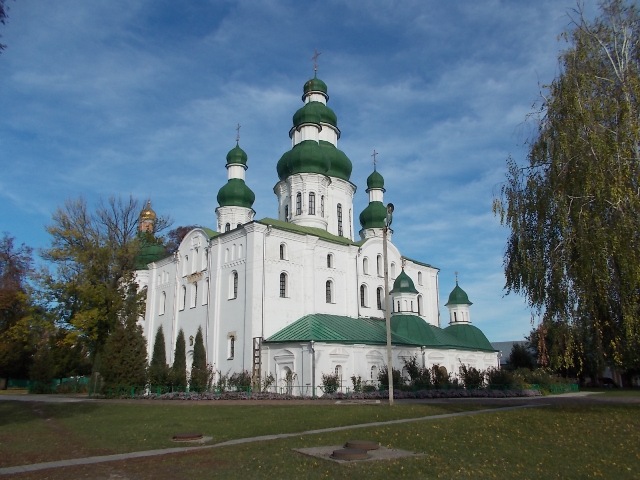
Chernigov monastery
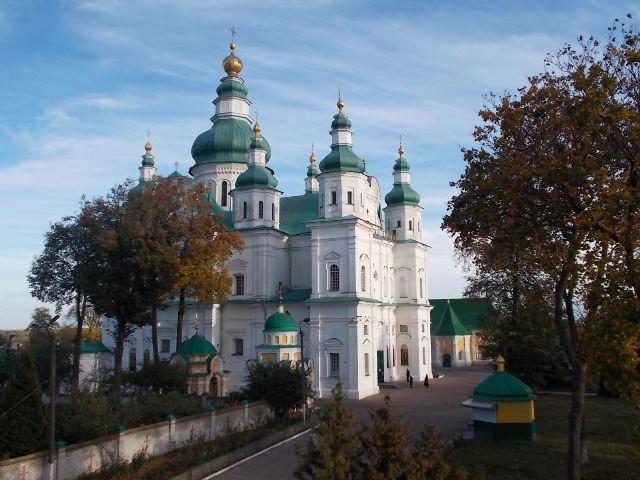
Next day, we returned to Pochaev Lavra and spent the night. Then we went to one of the youngest Russian monastery, the monastery of Banceni. We drove for, about, 5 hours. The distance between Pochaev and Banceni is 260 km. Just follow the road map and there will be no problem. The monastery is located after the city of Chernovtsy. The monastery is dedicated to the Ascension of the Lord. It was founded in 1994. It is well known for its shelter for orphans, but also by the home, in which they place children with disabilities. Monks and sisters, under the direction of abbot Michael, are taking care of the children. The documentary film “Fortress”, was filmed in this monastery.
Accommodation and food are free of charge, but everyone gives a donation. The monastery owns parts of the relics of St. Barbara, St. Seraphim of Sarov and a fraction of the Holy Cross.
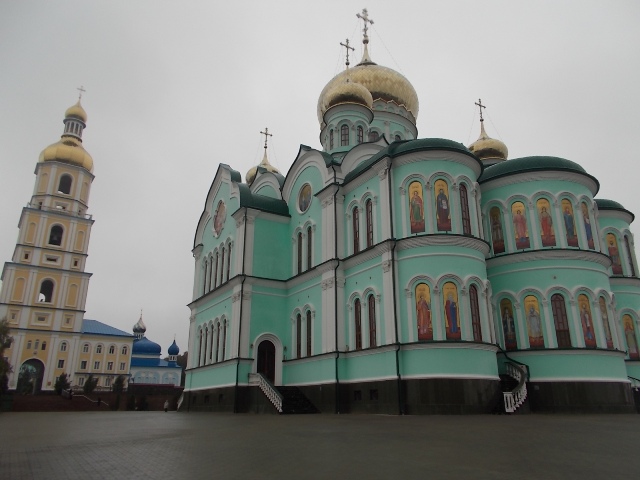
Monastery Banceni
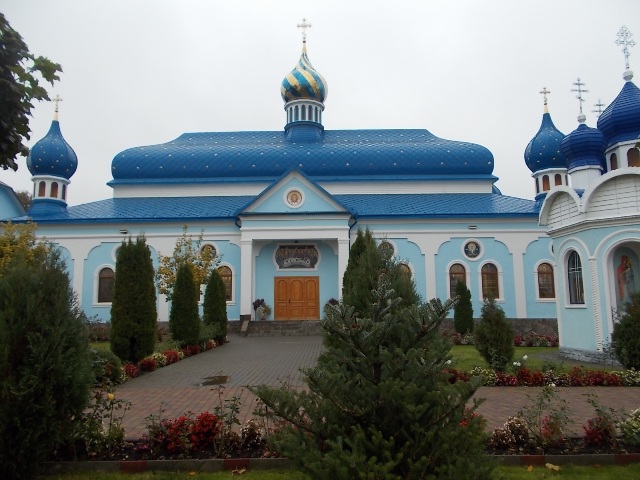
A few kilometers from the monastery, there is a skete of St. Xenia of Petersburg. The problem with all Ukrainian monasteries and sketes, is that there are no signposts towards them. But, if you have strong faith, God will open the way for you. As far as I remember, to the skete of St. Xenia of Petersburg, there is only one signpost. This skete is beautiful!
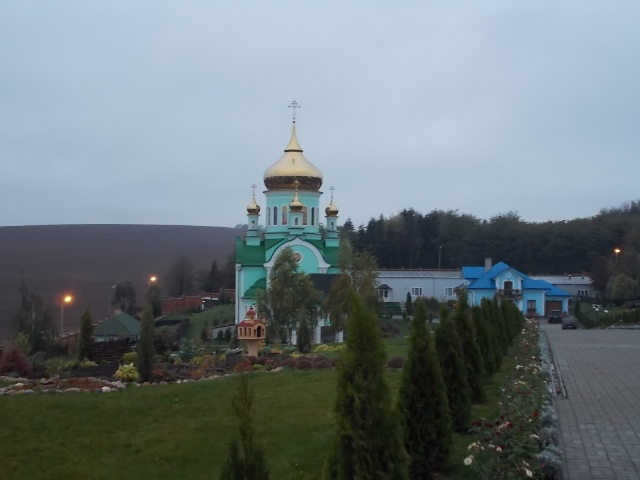
Skete of St. Xenia of Petersburg
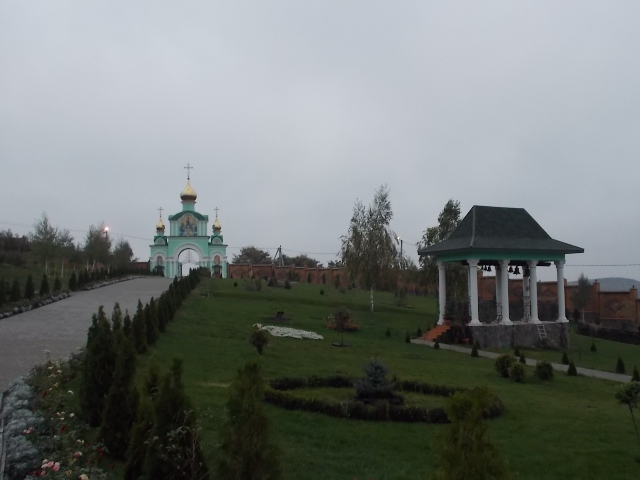
Monastery Banceni is located 40 km from the Ukrainian-Romanian border. We had the misfortune, that GPS led us to a side road. That was a nightmare! The side road is, in fact, macadam. There is no asphalt! On that road, you can see traffic signs, which is complete nonsense! The road passes through villages and towns, next to schools and municipal buildings! So, we drove those 20 km of macadam, for more than 2 hours! My recommendation is to go back, to Chernivtsi and, from there, head toward the border with Romania. That road is very good.
Our next stop is the Romanian city of Iasi, well known for the relics of St. Paraskevi, saint of Serbian origin. If we exclude travel by a macadam road, from Bancheni, Iasi could be reached in 3-4 hours of drive.
Iasi is a huge city, a university center. It has its own airport. Everyone knows where the relics of St. Paraskevi are, so it is not difficult to find the church. Romanians have great respect for this Serbian saint. Before and after work, they come to venerate her relics. Students do the same, before and after school.
The Romanians switched to the new calendar, so St. Paraskevi is celebrated on 14th October. We arrived at Iasi on Sunday, 16. October. The rain was pouring, and the river of people was patiently waiting, to enter the church. After half an hour of waiting, we entered the church. But, the relics of the saint were not in the church! They were taken outside, in front of the church. We had to take a detour, to the relics, go down for a couple of streets and stand in a line, at least 1 km long. The Romanians clearly marked the way to the relics. Every year, hundreds of thousands of pilgrims come to venerate the relics, on the feast of St. Paraskevi. The rain is still falling, it is quite cold, but the pilgrims are patiently waiting in line. Everyone is calm, although the rain is falling harder and harder. After an hour and a half, we reached the relics. Relics of St. Paraskevi are completely covered, but you can feel great grace from them. The priests stand aside and bless everyone, who bows to the relics. Amazing feeling!
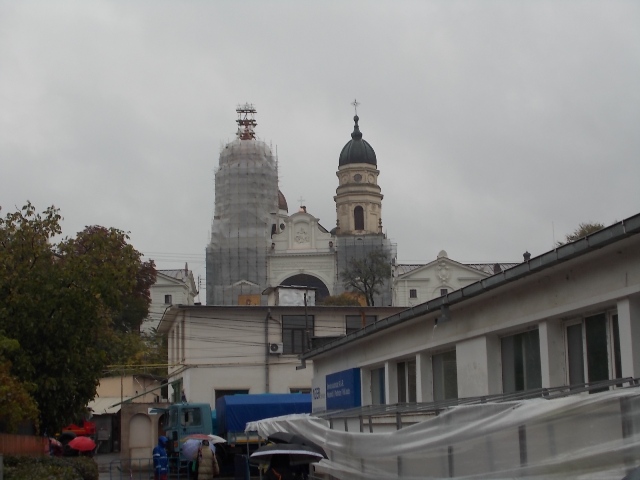
Church with the relics of St. Paraskevi
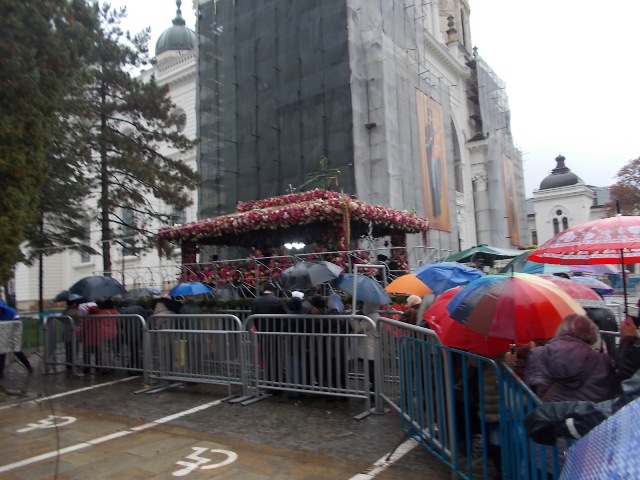
Relics of St. Paraskevi
From Iasi, we continued toward Targu Neamt. The distance is about 105 km, or about 2.5 hours of drive. At Targu Neamt, follow the signs for Targu Mures. Soon, you will come to the first signpost, towards the monasteries of Neamt (13 km), Secu (19 km) and Sihastria (24 km). There is a monastery at every few kilometers. The signposts are clear; there is no problem to follow it.
Monastery Neamt is the largest Romanian monastery. And one of the most significant and oldest. It is also called “Romanian Jerusalem”. It is dedicated to the Ascension of Christ. It was built at the end of the 14th century, but the first written traces of it are from 1407. The monastery is beautiful, like the monasteries of Mount Athos. In the monastery church are the relics of the Russian saint Paisius Velichkovsky, who came to Neamt in 1779, from Mount Athos. Thanks to him, the monastery became the spiritual center of Moldova and whole Romania. The monastery also has 7 hermitages, in the area.
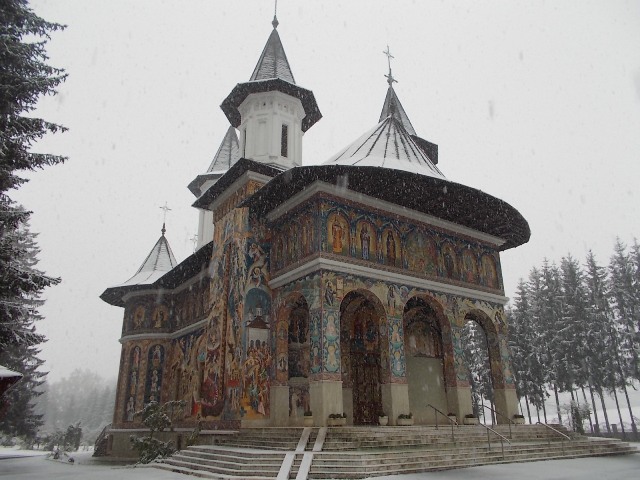
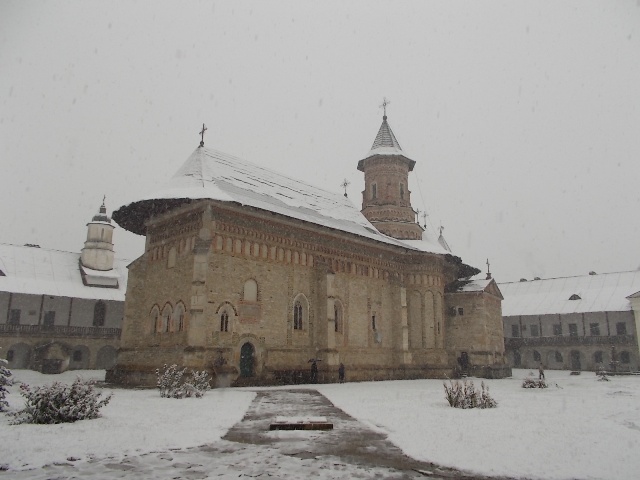
Monastiry Neamt

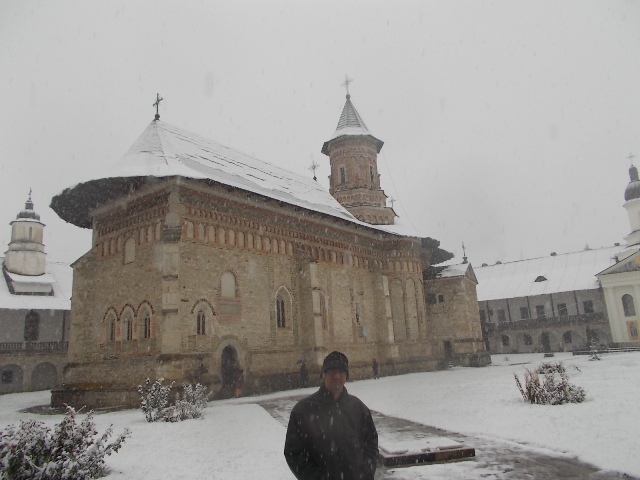
When you return, from monastery Neamt, to the highway, continue straight. You will notice the signpost, toward Secu monastery (turn left). From the turn, to the monastery, there is about 4 km. The same road leads to the monastery of Sihastria, which is 3 km away, from the monastery of Secu.
The main church of monastery Secu was built in 1602. It is dedicated to St. John the Baptist. The monastery is small, but very beautiful.
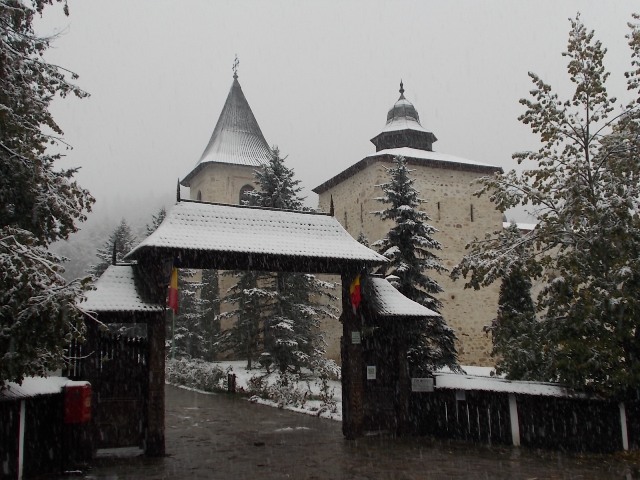
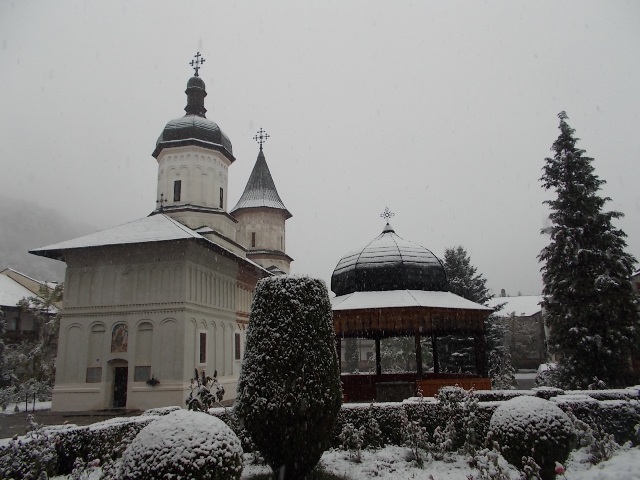
Monastiry Secu
Not far from the monastery of Secu (3 km), another famous Romanian monastery, Sihastria, lies. It was built in 1655, and dedicated to the Birth of the Most Holy Mother of God. The famous elder Cleopa (1912-1998), a great friend of Serbian St. Justin Popovic, was an abbot in Sihastria. Today, the cell of elder Cleopa is a museum. In this cell, you can see various interesting things, that belonged to the great elder, as well as a couple of books, in Serbian, about the elder. In the cell-museum, the monastic hat of St. Justin Popovic is kept. When, in 1999, Serbia and Montenegro were bombed, elder Cleopa said, with tears: “All Serbs will go to Paradise!” Elder Arsenie Papacioc (1913-2011), one of the latest Romanian great elders, also lived in this monastery.
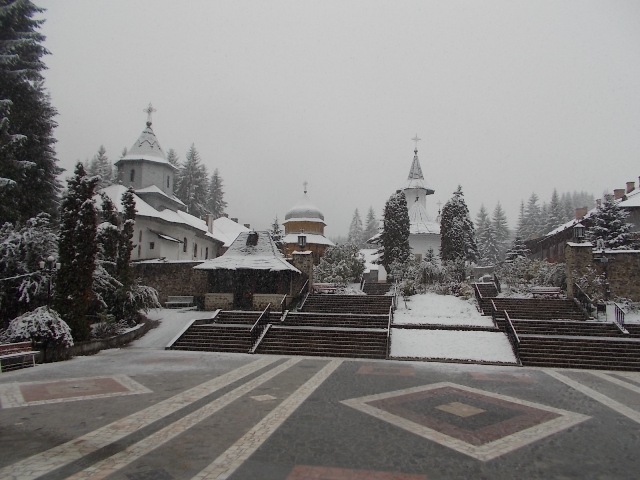
Monastiry Sihastria
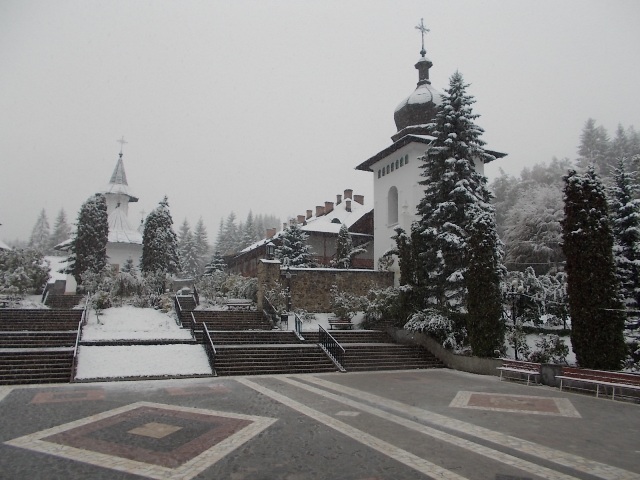
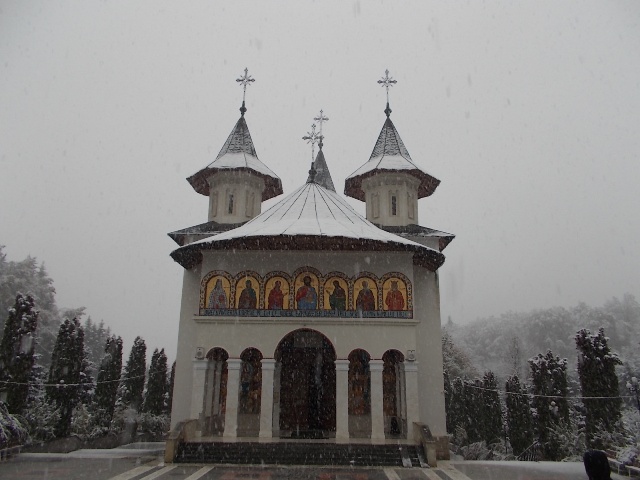

Elder Cleopa and St. Justin Popovic
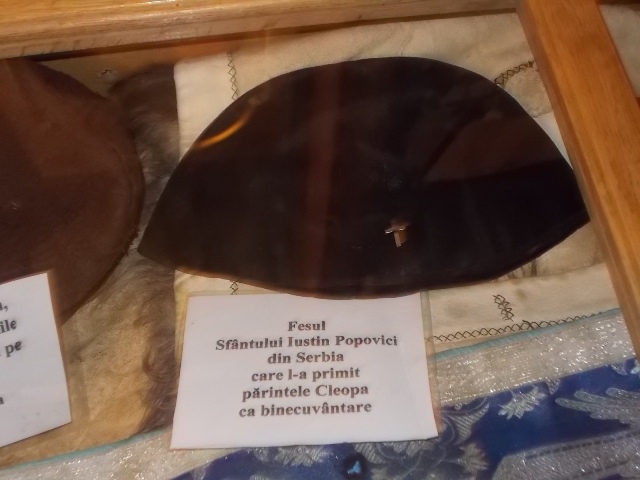
Monastic hat of St. Justin Popovic
This pilgrimage can be done in 7-8 days. One night, in Romania, is enough to visit some of the major sacred places. We crossed about 3600 km. It is really worth doing a tour like this. For a little money, you will have an experience that will last for a lifetime. The monasteries of Ukraine and Romania, are for people who are deep in faith. It took me a few trips, to Mount Athos, to understand some thing. In Ukraine, I understood those things right away! Ukraine will immediately “hit” you; with Mount Athos, it is going slowly. Experiences from the Pochayev and Kiev Lavra helped me to think deeply, about some of the things I am doing. Who is spiritual, he will return changed and reborn, from these holy places.
October 2016.

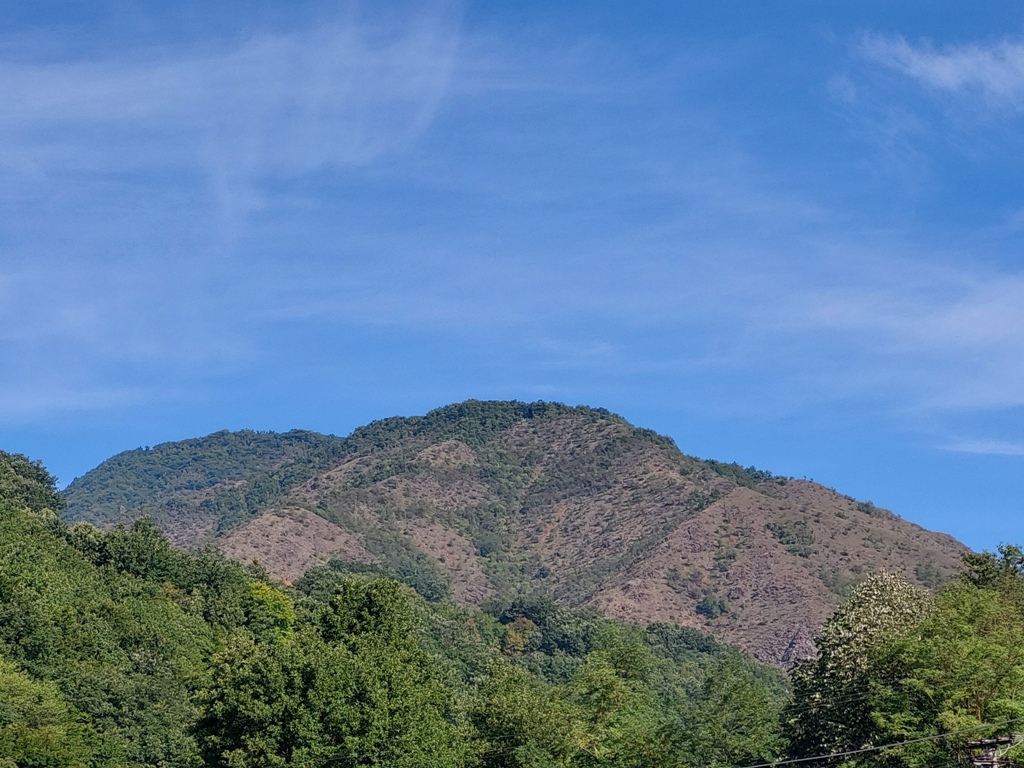
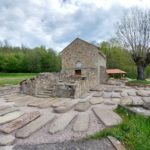
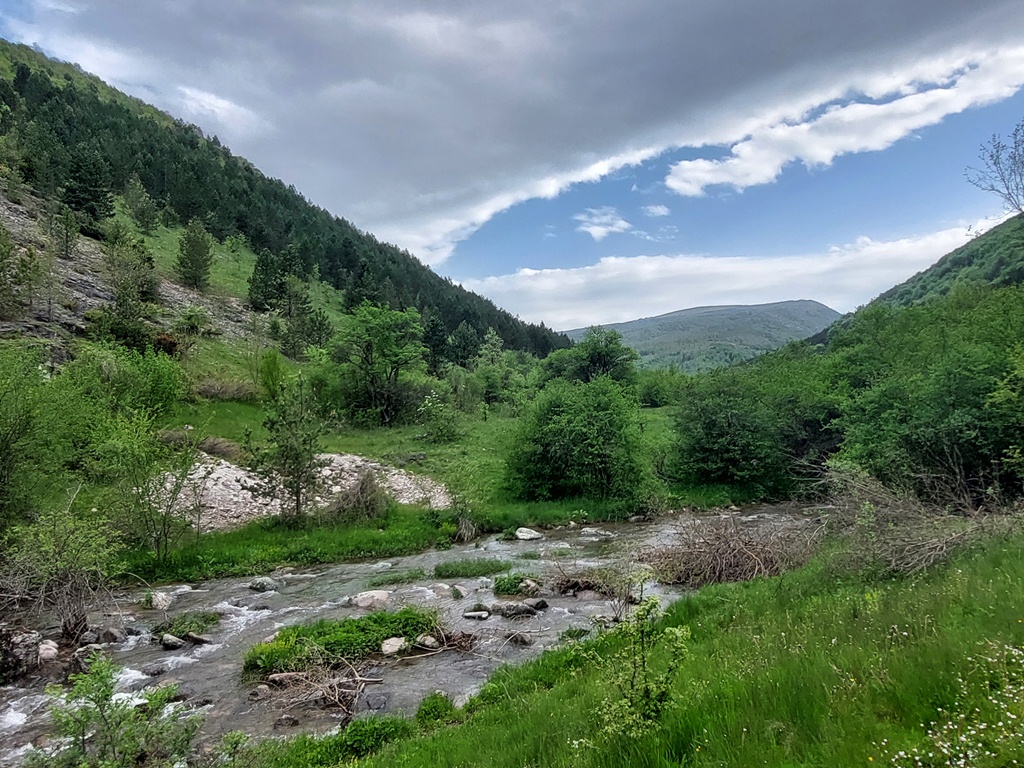
 Srbija na dlanu
Srbija na dlanu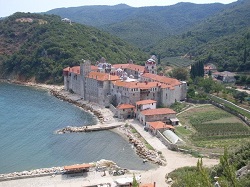 SVETOGORSKE TURE
SVETOGORSKE TURE Moja planeta
Moja planeta Vila Ćetković
Vila Ćetković Jooble
Jooble Outdoor Srbija
Outdoor Srbija